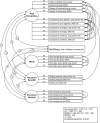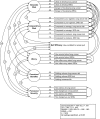Factor Structure and Stability of Smoking-Related Health Beliefs in the National Lung Screening Trial
- PMID: 25964503
- PMCID: PMC4757932
- DOI: 10.1093/ntr/ntv091
Factor Structure and Stability of Smoking-Related Health Beliefs in the National Lung Screening Trial
Abstract
Introduction: Absolute and comparative risk perceptions, worry, perceived severity, perceived benefits, and self-efficacy are important theoretical determinants of tobacco use, but no measures have been validated to ensure the discriminant validity as well as test-retest reliability of these measures in the tobacco context. The purpose of the current study is to examine the reliability and factor structure of a measure assessing smoking-related health cognitions and emotions in a national sample of current and former heavy smokers in the National Lung Screening Trial.
Methods: A sub-study of the National Lung Screening Trial assessed current and former smokers' (age 55-74; N = 4379) self-reported health cognitions and emotions at trial enrollment and at 12-month follow-up. Items were derived from the Health Belief Model and Self-Regulation Model.
Results: An exploratory factor analysis of baseline responses revealed a five-factor structure for former smokers (risk perceptions, worry, perceived severity, perceived benefits, and self-efficacy) and a six-factor structure for current smokers, such that absolute risk and comparative risk perceptions emerged as separate factors. A confirmatory factor analysis of 12-month follow-up responses revealed a good fit for the five latent constructs for former smokers and six latent constructs for current smokers. Longitudinal stability of these constructs was also demonstrated.
Conclusions: This is the first study to examine tobacco-related health cognition and emotional constructs over time in current and former heavy smokers undergoing lung screening. This study found that the theoretical constructs were stable across time and that the factor structure differed based on smoking status (current vs. former).
Published by Oxford University Press on behalf of the Society for Research on Nicotine and Tobacco 2015. This work is written by (a) US Government employee(s) and is in the public domain in the US.
Figures
References
-
- Rosenstock IM. Historical origins of the health belief model. Health Educ Monogr. 1974;2 (4):328–335. - PubMed
-
- Glanz K, Rimer BK, Lewis FM. Health Behavior and Health Education: Theory, Research and Practice. 3rd ed. San Francisco, CA: Wiley & Sons; 2002.
-
- Leventhal H. Findings and theory in the study of fear communications. Adv Exp Soc Psychol. 1970;5:119–186. 10.1016/S0065-2601(08)60091-X.
-
- Sheeran P, Harris PR, Epton T. Does heightening risk appraisals change people’s intentions and behavior? A meta-analysis of experimental studies. Psychol Bull. 2014;140(2):511–543. 10.1037/a0033065. - PubMed
Publication types
MeSH terms
Grants and funding
LinkOut - more resources
Full Text Sources
Other Literature Sources



